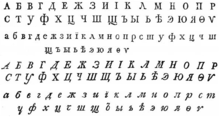Civil Script
This article has multiple issues. Please help or discuss these issues on the talk page. (Learn how and when to remove these template messages)
|

The Civil Script (Russian: Гражда́нский шрифт) or, colloquially, the Russian Cyrillic, is a modification of the Cyrillic script introduced by the Russian Tsar Peter the Great in the period from 1708 to 1710. The aim was to alter the appearance of Russian, making it more similar to Western European writing of that time (i.e., early Baroque Franco-Italian).

In January 1707, according to a draft probably made by Peter the Great himself. In the first quarter of the 19th century, the civil alphabet was adopted in Serbia and Bulgaria and gradually replaced the Church Slavonic alphabet. The reform of Peter I radically changed the development of the Russian alphabet and the Cyrillic alphabet as a whole. The development of the Cyrillic alphabet overtakes the Renaissance period from the development of typography in Western Europe and from the medieval stage, which is located until then, is equated with the late Baroque Latin typography. The genetic link between the Cyrillic alphabet and the Greek alphabet has been removed. Prior to this reform, centuries ago, the original Early Cyrillic alphabet orthographic bequest of the Preslav Literary School (9th-10th centuries), the later orthographic reform of the Tarnovo Literary School (14th and 15th centuries), also the Venetian term - followed the Greek calligraphic and typographic tradition.[1] [2]
Encoding[]
The IETF language tags have registered ru-petr1708 for text from the Peter reforms of 1708 until the 1917 reforms.[3]*
References[]
- ^ "ЭСБЕ/Гражданский шрифт — Викитека". ru.wikisource.org. Retrieved 2020-02-05.
- ^ Silent Communication: Graffiti from the Monastery of Ravna, Bulgaria. Studien Dokumentationen. Mitteilungen der ANISA. Verein für die Erforschung und Erhaltung der Altertümer, im speziellen der Felsbilder in den österreichischen Alpen (Verein ANISA: Grömbing, 1996) 17. Jahrgang/Heft 1, 57–78.
- ^ "IETF Language Subtag Registry". IANA. 2021-08-06. Retrieved 7 October 2021.
See also[]
- Cyrillic typefaces
- History of the Russian language
- Government reform of Peter the Great
- 1708 establishments in Russia
- Spelling reform